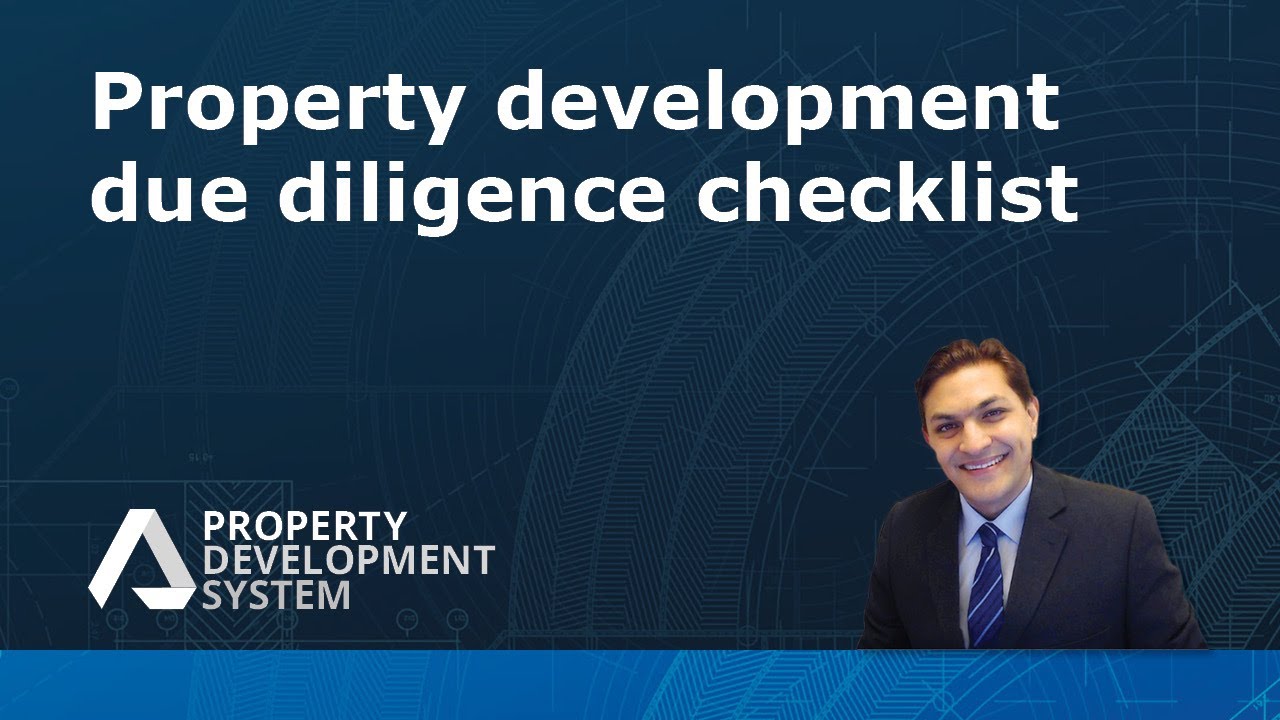Property development due diligence - Overview
How to conduct detailed property development due diligence?
Key Property Development Due Diligence Concepts
Target Market
- Identify whether the development targets owner-occupiers, investors, or is for rental purposes.
Local Development Trends
- Assess what’s being built in the area (e.g., townhouses, apartments, single homes).
Builders in Area
- Identify the main builders operating locally, as they are familiar with council regulations and consultants.
Design Preferences
- Determine preferred designs in the area, like the popularity of two-bedroom townhouses vs. three-bedroom ones.
Demand for Designs
- Research market demand for specific designs and configurations.
End Value Estimation
- Estimate the potential sale or rental value of the development using various resources.
Comparable Sales
Investigate sales in the area to gauge the market rate.
Rental Market Analysis
- Compare rental yields of new vs. old properties.
Due Diligence Phases
Pre-Selection Phase:
- Focus on location, including proximity to public transport, schools, and shopping areas.
Post-Selection Phase:
- Consider highest and best possible use of the site, physical characteristics (zonings, overlays), local council support, and site history (previous use, contamination risks).
Gap Analysis:
-
Evaluate the difference between current demand and supply.
-
Utilize data from ABS, development applications, and other resources to determine market needs and development potential.
Legal Considerations:
- Engage professionals for legal advice on restrictive covenants, property searches, and potential issues with the land or site history.
Insights Based on Numbers
Rental Yield Analysis:
- Comparing yields of different property types provides insights into the most lucrative investment options.
Sale Value Projections:
- Assessing potential sale values helps in calculating feasible investment returns.
Land Value Consideration:
- Understanding the actual value of land in feasibility studies is crucial to avoid overpaying and to ensure profitability.
What are the most sought-after property types in terms of design and size in the targeted area?
- The video outlines that a crucial aspect of property development due diligence is understanding the demand for various property types, designs, and sizes in the target area. This involves:
Assessing Local Trends: Researching what is currently being built in the neighborhood, such as townhouses, apartments, or single homes.
Design Preferences: Identifying the preferred property designs in the area, for example, whether two-bedroom townhouses or three-bedroom ones are more popular.
Market Demand: Investigating the market demand for specific property configurations. This includes understanding whether designs like two-bedroom apartments or three-bedroom townhouses are more favored by buyers or renters in the area.
Consulting with Agents: Engaging with local real estate agents to get insights into what property types are selling more and what potential buyers or renters are looking for. Agents can provide valuable information on trends, such as the preference for additional features like ensuite bathrooms or powder rooms.
- Understanding these factors is essential for developers to ensure that the properties they develop align with the market demand, leading to quicker sales or rentals and potentially higher returns on their investment.
How do local council regulations impact property development in the selected area?
The video emphasizes the significant impact of local council regulations on property development. Key points include:
Zoning and Overlays: Understanding the zoning and overlays of a site is critical. Zonings determine what types of buildings are permissible, while overlays might impose additional requirements or restrictions. For instance, some overlays might be pro-development, facilitating smoother planning applications, while others might impose limitations that could affect the viability of the project.
Council Familiarity: Builders who frequently work in a specific area are often more familiar with the local council’s expectations and regulations. This can lead to more efficient development processes.
Council Support: Having a preliminary meeting with the council’s Town Planning Department is advised to gauge their attitude towards the proposed development. The council’s support or lack thereof can significantly influence the feasibility and timeline of a project.
Infrastructure Requirements: The council might require developers to undertake certain infrastructure upgrades, which could affect the project’s profitability. Developers should be wary of developing in newly developing areas or “out of the way” locations where such requirements might be more stringent.
Risk Mitigation: Being in a good location can mitigate risks. If a development faces delays in selling, being in a location with high demand for rentals can provide an alternative income stream through renting out the properties.
These points highlight the importance of thorough research into council regulations and active engagement with local authorities during the due diligence phase of property development. Understanding and adhering to these regulations is crucial for the smooth execution and success of a development project.
What are the key legal aspects to consider in property development due diligence?
The video highlights several crucial legal considerations in the property development due diligence process:
Engaging Professionals: It’s recommended to hire a professional lawyer or conveyancer to navigate the legal complexities of property development. They play a critical role in reviewing legal documents and conducting necessary property searches.
Reviewing Legal Documents: Particular attention should be given to documents like Section 32 or disclosure statements. These documents contain vital information about the property, including any easements, covenants, or other restrictions that might impact development plans.
Property Searches: Conducting thorough property searches is crucial. This includes understanding boundary lines, party wall arrangements, and identifying any restrictive covenants on the site.
Caveats and Security Interests: Checking for any existing caveats or security interests registered against the land is important, as these can affect the development rights or impose additional obligations.
Restrictive Covenants: Identifying any restrictive covenants is crucial. For instance, a single dwelling covenant on a large block of land can significantly limit development potential, restricting the owner to build only a limited number of dwellings.
Site History and Contamination Risks: Understanding the site’s history, especially if it has been used for industrial purposes, is vital. Sites previously used as petrol stations, for example, may have soil contamination issues, requiring costly decontamination.
Local Council Regulations: Legal compliance with local council regulations, including zoning laws and development permits, is essential to avoid legal challenges and delays in the development process.
These legal aspects are critical to the success of a property development project, as overlooking them can lead to significant financial and legal repercussions. It’s always advisable to conduct comprehensive legal due diligence and seek professional advice before proceeding with any development.
Test Your Knowledge
Objective
The purpose of this exercise is to provide students with a practical understanding of conducting detailed property development due diligence. Through this assignment, students will apply the key concepts outlined in the article to a hypothetical property development project.
Instructions
- Select a Location: Choose an urban area you are familiar with or interested in. This will be the target location for your hypothetical property development project.
Research Phase
Conduct thorough research based on the guidelines provided in the article. Your research should cover the following aspects:
Market Analysis
- Target Market: Identify whether your development will target owner-occupiers, investors, or renters.
- Local Development Trends: Assess the types of properties being built in your chosen area (e.g., townhouses, apartments, single homes).
- Builders in the Area: List the main builders operating in your area and note any specific council regulations or design trends they follow.
- Design Preferences and Demand: Determine the preferred property designs and configurations in the area, backed by market demand data.
Due Diligence Phases
- Pre-Selection Phase: Analyze the location’s proximity to amenities like public transport, schools, and shopping areas.
- Post-Selection Phase: Evaluate the site’s potential, considering zoning, overlays, local council support, and any site history that could impact development (e.g., previous use, contamination risks).
- Gap Analysis: Perform a gap analysis to identify the difference between current market demand and supply.
Legal Considerations
- Engage in hypothetical consultations with legal professionals to understand restrictive covenants, necessary property searches, and potential legal issues with the land or site history.
Report Writing
- Compile your findings into a detailed report. Your report should include an introduction to the chosen location, research findings covering the above aspects, and a conclusion summarizing the viability of the proposed development project.
Questions and To Do’s:
- Identify the Target Market:
- Who is the primary target market for your development? Justify your choice based on demographic and economic factors in your selected area.
- Local Development Trends and Demand:
- What types of properties are currently being developed in your chosen area? Why do you think these types are popular?
- Based on your research, what property design and size seem to be in highest demand? Support your answer with data or insights gathered from real estate agents or market analysis.
- Legal and Council Regulations Impact:
- Describe how local council regulations could impact your proposed development. Include zoning, overlays, and potential infrastructure requirements.
- Outline key legal considerations you must address before proceeding with the development. How would you ensure compliance with these legal requirements?
- Financial Analysis (Optional Advanced Task):
- Conduct a basic financial analysis to estimate the potential sale or rental value of your development. Compare this with the estimated development costs to assess the project’s feasibility.
Research Questions
- What are the most sought-after property types in your area in terms of design and size? How did you determine this?
- How do local council regulations and zoning laws in your area influence property development?
- What key legal aspects must be considered during the due diligence process for property development in your chosen location?
Deliverables
- A detailed report including all the research findings, analyses, and justifications for your decisions.
- A presentation summarizing the key points of your due diligence process and your final recommendations regarding the project’s viability.
Submission Guidelines
- Submit the report and presentation slides in PDF format by responding below.
- Ensure all sources of information are properly cited within your report.
- Presentations will be conducted in class or via a scheduled online session, with each group allotted [insert time limit] minutes to present their findings.
Assessment Criteria
- Depth and breadth of market analysis and due diligence research.
- Understanding and application of the key concepts outlined in the article.
- Quality of analysis in identifying target market, legal considerations, and financial viability.
- Clarity, organization, and professionalism of the final report and presentation.


